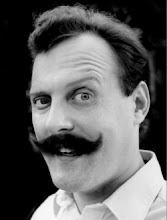skip to main |
skip to sidebar
Movie Tech
When Were Movie Gun Sound Effects Invented?
Vanessa, of Seattle Washington, asks:Pondering who invented the "sound" of gunfire?
Vanessa, The very first motion picture was driven by an electric motor, and had synchronized sound. Did you know that?
Unfortunately, Mr. Edison's Kinetoscope - Kinetophone (Camera - Projector) 1894 show, entitled "Dickson Experimental Sound Film," did not alas have gunshots in its track.
Commercial sound movies wouldn't be offered until 1929, but another popular medium - Radio - developed soundtrack production, all through the 1920s. Dramatic shows on radio often needed guns, BUT... gun sounds were problematic.
Gunshots are "impulse noise" which means "very suddenly very loud," and then the decay must match a room characteristic. Echo, reverb, etc.
That means "real" gunshots only POP weakly, like firecrackers, because they just shut down mics and electronics. It took a long while to learn to record them.
During development of Sound Movies, Mr. Jack Donovan Foley created the Art of "Post-sync recording," at Universal, in 1927. We still call "Performing sound effects live to picture" by his name - "Foley." If anybody invented movie "Gunshots," it was he.
Sound movies arrived in 1929, with Warner Brothers' "Don Juan" and "The Jazz Singer." When movie tracks needed guns, it was quickly noticed that the sound of REAL guns is flabby, ineffective, and weak.
Often, the Radio technique of hitting a cardboard box with a wooden slat was used, because its Attack was softer, a slow sound to simulate gunshots. They tried everything else. Hitting an oil drum, hitting a wooden box, etc.
For 1930s - 1940s Westerns, they recorded the sound of full-load blank cartridges, black powder rounds, making a softer sound than modern smokeless powder, and smaller (1/4 and 1/8 sized) powder loads.
When it became possible to edit sound effects, on optical film and then magnetic tape, sound was improved, and whole libraries were compiled. Each studio had its own jealously guarded Sfx (sound effects) library, on disc and tape and magnetic and optical film.
They recorded everything - Bullet striking flesh, bullets striking wood, bullets on pavement, bullet ricochet,etc. Gunshots, percussion cap weapons, machine guns, and automatic rifles.
For a long time, the best Sfx libraries available were the BBC Library, and the Valentino Brothers Library. I had both, and it was a big deal when they became available for sale.
Then three movies changed movie sound, and one could license their Libraries for use. All this changed seemingly overnight.
When Walter Murch created the sound (and the term "Sound Designer") for Francis Ford Coppola's "Apocalypse Now," he had to create all the location gunfire and other tracks, from scratch. All this great war footage - and it was all silent. Mr. Murch invented a way to record Foley...outside, to video playback.
They recorded guns, with modern mics and electronics, even the sound of spent brass cartridges, hitting the ground.
Then they equalized them, boosting the frequencies they wanted to hear. Dynamic range was controlled by careful electronic limiting. Suddenly guns sounded close-miked, big and fat, and more real then real.
Same thing happened with the Sfx for George Lucas's "Star Wars" movies (1977 - 1983) with Sound Design by Ben Burtt. I never heard such good sound effects, as were in those films.
"Raiders Of the Lost Ark" (1981) brought in newly recorded new guns, and movie gunfire and location effects now were fresh and exciting to listen to.
Ben Burtt and his crew cheated big guns over little ones, and for me, from "Apocalypse Now" to "Raiders Of The Lost Ark," THAT is where gunshots really started sounding great.
INDIANA JONES Sound Design Featurette part 1
INDIANA JONES Sound Design Featurette part 2
-- Sam Longoria

No comments:
Post a Comment